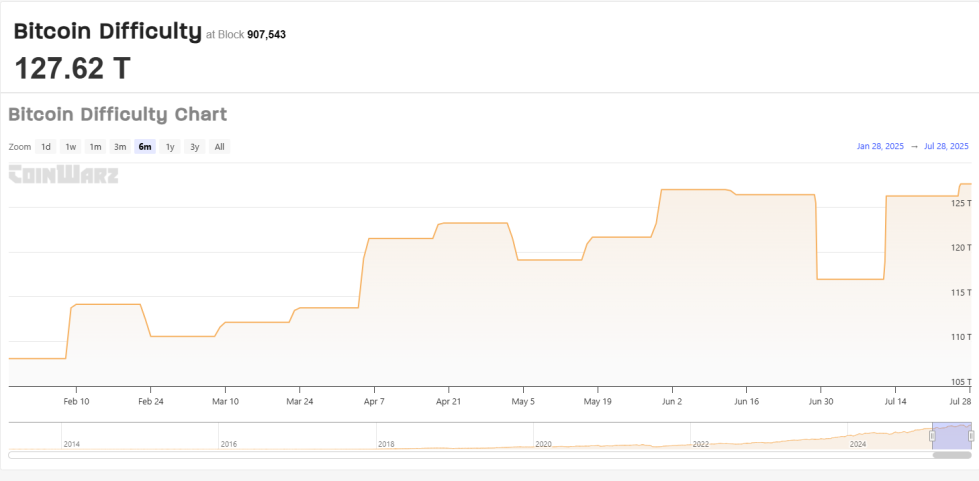On-chain data shows the weekly average Bitcoin Hashrate has surged to 942 EH/s, putting it within striking distance of the all-time high (ATH).
Bitcoin Hashrate Has Gone Through A Recovery Run
The “Hashrate” refers to a Bitcoin indicator that keeps track of the total amount of computing power that miners have currently attached to the blockchain. Miners have to employ this power because BTC uses a consensus mechanism based on proof-of-work (PoW).
In this framework, validators compete against each other using computational resources to be the first to solve the next block. As such, the total network power, which the Hashrate measures, never actually works in tandem, but the metric can still be useful, as it provides insights into the situation of the miners as a whole.
When the value of the indicator rises, it means new miners are joining the blockchain and/or existing ones are expanding their facilities. Such a trend can be a sign that BTC mining is appearing attractive to these validators.
On the other hand, the metric observing a drop suggests some miners have decided to pull their machines out of the network, potentially because they are no longer finding mining profitable.
Now, here is a chart from Blockchain.com that shows the trend in the 7-day average Bitcoin Hashrate over the past year:

As displayed in the above graph, the 7-day average Bitcoin Hashrate plummeted to a low of about 796.2 exahashes per second (EH/s) exactly one month ago: June 28th. This drop may have been a result of the asset’s rally stalling into a phase of consolidation.
Miners make the major part of their income through the block subsidy, a fixed BTC-denominated reward that miners receive upon successfully adding a block to the chain. The value of this reward naturally goes up as the asset’s price rises, so miners often react to price moves to expand or decommission.
Following last month’s low, the Hashrate made some recovery, suggesting miners readded power. This expansion continued as the asset’s price broke out of its flat movement and explored new ATHs.
Interestingly, even though BTC has again cooled off a bit in the last couple of weeks, miners have shown another recovery push that has now brought the indicator’s 7-day average value to 942 EH/s, which is just below the record of 943.6 EH/s set in mid-June.
The development has also come despite another factor going against the miners: a new ATH in the Bitcoin Difficulty.

As the above chart from CoinWarz shows, the Bitcoin Difficulty has hit a value of 127.62 terahashes, higher than the previous record of 126.98 terahashes set last month.
The Difficulty is a metric built into the BTC blockchain that controls how hard miners would find it to discover the next block. It exists to achieve one thing: make sure the miners can only receive block subsidy at gaps of about 10 minutes. This means that no matter how much computing power miners add, they will always still earn the same income.
Why do these validators even add power at all then? The answer is simple: they still require more power to compete on the network. The Hashrate has trended up throughout BTC’s history and it may continue to do so in the coming future. Miners who don’t expand enough to keep up with the blockchain-wide increase will fall behind and thus, earn lesser revenue.
BTC Price
At the time of writing, Bitcoin is floating around $118,900, up 1% in the last week.

Trusted Editorial content, reviewed by leading industry experts and seasoned editors. Ad Disclosure
On-chain data shows the weekly average Bitcoin Hashrate has surged to 942 EH/s, putting it within striking distance of the all-time high (ATH).
Bitcoin Hashrate Has Gone Through A Recovery Run
The “Hashrate” refers to a Bitcoin indicator that keeps track of the total amount of computing power that miners have currently attached to the blockchain. Miners have to employ this power because BTC uses a consensus mechanism based on proof-of-work (PoW).
In this framework, validators compete against each other using computational resources to be the first to solve the next block. As such, the total network power, which the Hashrate measures, never actually works in tandem, but the metric can still be useful, as it provides insights into the situation of the miners as a whole.
Related Reading: XRP Adoption Strong: 7,500 Addresses Joining Every Day
When the value of the indicator rises, it means new miners are joining the blockchain and/or existing ones are expanding their facilities. Such a trend can be a sign that BTC mining is appearing attractive to these validators.
On the other hand, the metric observing a drop suggests some miners have decided to pull their machines out of the network, potentially because they are no longer finding mining profitable.
Now, here is a chart from Blockchain.com that shows the trend in the 7-day average Bitcoin Hashrate over the past year:

The 7-day value of the metric appears to have been following an upwards trajectory in recent days | Source: Blockchain.com
As displayed in the above graph, the 7-day average Bitcoin Hashrate plummeted to a low of about 796.2 exahashes per second (EH/s) exactly one month ago: June 28th. This drop may have been a result of the asset’s rally stalling into a phase of consolidation.
Miners make the major part of their income through the block subsidy, a fixed BTC-denominated reward that miners receive upon successfully adding a block to the chain. The value of this reward naturally goes up as the asset’s price rises, so miners often react to price moves to expand or decommission.
Following last month’s low, the Hashrate made some recovery, suggesting miners readded power. This expansion continued as the asset’s price broke out of its flat movement and explored new ATHs.
Interestingly, even though BTC has again cooled off a bit in the last couple of weeks, miners have shown another recovery push that has now brought the indicator’s 7-day average value to 942 EH/s, which is just below the record of 943.6 EH/s set in mid-June.
The development has also come despite another factor going against the miners: a new ATH in the Bitcoin Difficulty.

The trend in the BTC Difficulty over the last six months | Source: CoinWarz
As the above chart from CoinWarz shows, the Bitcoin Difficulty has hit a value of 127.62 terahashes, higher than the previous record of 126.98 terahashes set last month.
The Difficulty is a metric built into the BTC blockchain that controls how hard miners would find it to discover the next block. It exists to achieve one thing: make sure the miners can only receive block subsidy at gaps of about 10 minutes. This means that no matter how much computing power miners add, they will always still earn the same income.
Related Reading: Bitcoin OG From 2011 Wakes Up, Cashes In On A 322,000x Gain
Why do these validators even add power at all then? The answer is simple: they still require more power to compete on the network. The Hashrate has trended up throughout BTC’s history and it may continue to do so in the coming future. Miners who don’t expand enough to keep up with the blockchain-wide increase will fall behind and thus, earn lesser revenue.
BTC Price
At the time of writing, Bitcoin is floating around $118,900, up 1% in the last week.
Looks like the asset's price has been consolidating recently | Source: BTCUSDT on TradingView
Featured image from Dall-E, CoinWarz.com, Blockchain.com, chart from TradingView.com

Editorial Process for bitcoinist is centered on delivering thoroughly researched, accurate, and unbiased content. We uphold strict sourcing standards, and each page undergoes diligent review by our team of top technology experts and seasoned editors. This process ensures the integrity, relevance, and value of our content for our readers.



 Bitcoin
Bitcoin  Ethereum
Ethereum  XRP
XRP  Solana
Solana  Dogecoin
Dogecoin